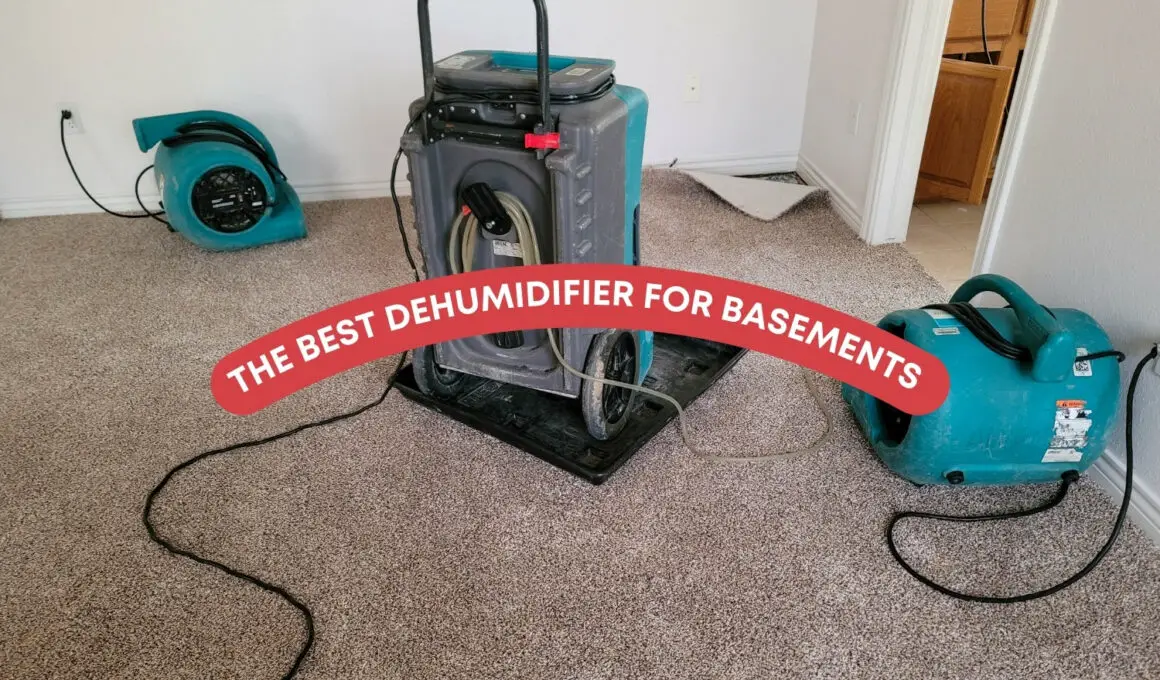Table of Contents Show
As someone with over 13 years of experience dealing with various home maintenance issues, I know how crucial maintaining a healthy and safe living environment is. One of the key aspects that often gets overlooked is the importance of managing humidity levels, especially in the basement. Testing these basement dehumidifiers is such a big deal for me, but I’m glad to be able to share the results today; coming up on top is the Frigidaire FFAD3533W1 Dehumidifier with the most notable thing about it being the ability to remove dampness and smell fast. Here are six other dehumidifiers for basement we tested for this guide.
The Best Dehumidifier For Basements At A Glance
Basements are typically the most humid parts of a home, as they are below ground level and often lack proper ventilation. Excessive moisture can lead to various problems such as mold and mildew growth, damage to your house’s structure, and even health issues for you and your family.
Over the years, I’ve found that one of the most effective solutions to this issue is the use of a dehumidifier specifically designed for basements.
In today’s post, we will delve into the significance of owning a dehumidifier for your basement, what factors to consider when purchasing one, and of course, my top picks for the best basement dehumidifiers in 2023.
Whether you are a first-time buyer or looking to upgrade your current dehumidifier, this guide aims to simplify your buying process and help you make the most informed decision.
The Best Dehumidifier For Basements 2023: Tested By Pros
We all know that sultry summer means a higher humidity level and that is not just outside but in your basement as well which is why you need a dehumidifier. Our tester did a test on some dehumidifiers from top brands by evaluating their performance, ease of use, efficiency, and high capacity unit and we found 7 that were remarkable in all factors.
1. Frigidaire FFAD3533W1 Dehumidifier
Frigidaire FFAD3533W1 Dehumidifier is a 35-pint capacity dehumidifier, it is designed with a large humidity capacity to work for both finished and unfinished basements. This model has been selected as our top overall as it’s highly rated and can quickly reduce the humidity of a moderately sized basement. We found that it handles larger spaces well too.
This dehumidifier comes with easy-to-use features and from unboxing to plugging, it takes just 10 minutes to do that. There is an indicator that lights up red when the bucket needs to be drained, although it doesn’t have a pump, you can’t drain the water at an elevated level such as down a sink drain, but it does have a hose.
There are quite a lot of things to love about this dehumidifier. Not only will this help improve the air quality but it also has a filter that helps capture dust which is another air contaminant in the basement.
In addition, it is very quiet so you can move it to a common area in your home without worrying about it making uncomfortable noise. It comes in highly recommended, and our tester found it to be a great model for its value.
2. Midea 3,000 Sq. Ft. Energy Star Certified Dehumidifier
Midea 3,000 Sq. Ft. Energy Star Certified Dehumidifier is one of the sleeker and trusty models we found in the market. If you are only dealing with moderate humidity in your basement in finished basement, this 35-pint model from Midea is one that perfectly caters to that based on our extensive test.
This dehumidifier runs quietly while still being able to clear humidity out of 3000 square feet of space and it comes in under $200 too.
Midea is a reputable manufacturer in this category, and based on our experience using their products in the past, we expected this to do a superb job, and we found it to be a solid option. It removes up to 35 pints of moisture per day from the air, and even though it weighs 33 pounds, it sits on the wheel, making it easier to transport from one place to the other.
Another key feature of the dehumidifier is that it has an auto defrost function so it’s safer for use in the basement or other colder rooms. However, it is fairly bulky and it’s been a little harder to find this season. Also, if you have a compact basement, you might want to consider a smaller unit.
3. Pro Breeze Portable Dehumidifier
Pro Breeze Portable Dehumidifier is not bulky and won’t take up much space too. If you are dealing with only a little moisture in the bathroom or confined space, this comes in handy, it’s a model you can save money on without sacrificing comfort and value.
The installation is found to be a very easy process, you just have to plug into any standard outlet and let it ruin.
While there aren’t many features and settings with this dehumidifier, it will automatically shut off once the tank is full and there is also a light indicator that illuminates. We found this model to be convenient, and thanks to its translucent water tank, it is easy to monitor, and you can easily keep up with it as well.
This unit works perfectly, but for larger spaces, you might need more units strategically placed all around to ensure that all the air circulates. Keep in mind that this model is designed for rooms up to 150 Square feet. But despite its size, we found this to be very effective, especially for basements that do not need much humidity.
4. GE Energy Star Portable Dehumidifier
Another dehumidifier picked for its stellar performance is the GE 50 Pint Dehumidifier, this is designed to move water up to 16 feet away from the unit while it also allows you to position it in the ideal place for air circulation while you can keep using it in continuous mode.
The drainage hose for the pump is included, which is rare with other dehumidifiers.
GE Energy Star Portable Dehumidifier’s three fan levels also allow it to quickly circulate air through the units, especially on muggy days. We also love that the water tank is easy to remove, although it is heavy; there are however caster wheels and picket handles included so you can easily move it from room to room.
This is an expensive dehumidifier but a worthy investment after testing all the features it offers. Unlike other dehumidifiers, this model had an audible full tank alert which is something you will find convenient when you opt not to use continuous drainage. However, we note that it’s loud when operating on higher fan settings, but regardless, it’s a great model.
5. Honeywell 30 Pint Energy Star Smart Dehumidifier
It can be a bit hard to manage small basements, especially in older homes, mainly because you typically don’t frequent them often unlike a large basement.
The Honeywell 30 Pint Smart Dehumidifier has been picked as the perfect option for small basements after our extensive test, it is much lighter than other models and very easy to empty as well.
This dehumidifier has a compatible smartphone app that makes it easy for you to know when the water tank needs to be emptied, and you can also check the life readings to know how close it is to your desired percentage. We found this easy to set up, and it was quickly added to our list of favorites after testing.
In addition, the compact feature lets you move it around easily, and also with the app, you can automatically adjust the humidity level on the dehumidifier based on the weather in your surrounding area. It can be easily tucked into a corner due to its compact size without taking up much space.
6. hOmeLabs 4,500 Sq. Ft Energy Star Dehumidifier
Next on the list of best basement dehumidifiers is the hOmeLabs 4,500 Sq. Ft Energy Star is perfect for larger basements that are hard to monitor.
This is one of the most popular options in the market for large basements, it can be used as a continuous draining unit, and we are especially fond of how this dehumidifier quickly adjusts the humidity level in the basement it was placed.
This dehumidifier does not come with a hose, but it is easy to know when the water tank is full. Also, if you don’t want to run drainage hoses, or have no accessible drain, let the condensation collect in the water tank and empty it yourself.
In addition to some of its wonderful key features, it will automatically shut off, and an indicator light will also turn on. You can set this dehumidifier at a comfort level to determine the best humidity in the room. It can also quickly remove humidity from the area with the highest fan setting.
Although this is very expensive, we think it’s a worthy investment for homeowners who find it hard to control damp unfinished large basements. You can purchase a hose separately or use a garden hose.
7. Midea Cube 50 Pint Dehumidifier
Midea is one of the top brands that can be trusted to produce reliable dehumidifiers. This model is one we tested and found perfect for homeowners who like synchronizing their appliances and remotely monitoring their statuses.
This is a worthy investment and we did enjoy testing it as well, it was discovered to have an intuitive interface and amazing digital controls.
This model is compatible with smart home hubs like Amazon, Alexa, and Google Home. These dehumidifiers smartphone app delivers notification and there is also a detailed instruction manual that can be easily referenced when you have questions.
In our tests, we found that it does require effort to roll and after just a few days of use, mildew was found to be forming inside the tank, so this means you will be required to wash the tank every time you empty it to be safe.
This is the only issue we found, and it can be due to the model having a large external fan. But aside from this, we are impressed with the design and intuitive features.
Why You Need a Dehumidifier For Your Basement
It’s all too easy to ignore the dampness in our basements. We tend to treat basements as out-of-sight, out-of-mind spaces for storage or seldom-used items. But believe me, in my 13 years of homeownership and cleaning expertise, I’ve seen what happens when we neglect basement moisture – it’s not pretty.
Let’s start with the most common and troublesome problem – mold. Excess moisture creates an ideal environment for mold and mildew to grow. These fungi damage your home’s structure and can cause a slew of health problems, from minor allergies to severe respiratory conditions.
Moreover, high humidity can also be detrimental to the structural integrity of your home. It can cause wood to warp, paint to peel, and even your home’s foundation to crack. Over time, these issues can result in expensive repairs or decrease your home’s value.
Lastly, a damp basement can attract pests such as termites, cockroaches, and rodents that thrive in such conditions. These pests can cause additional damage to your home and even spread diseases.
This is where a basement dehumidifier steps in as a hero. It removes excess moisture from the air, creating an inhospitable environment for mold, pests, and the like. Furthermore, it helps to protect the structural integrity of your home and maintain a healthy atmosphere.
In my experience, a good dehumidifier is a small investment that saves you from potentially significant expenses and hassles down the road. Now that we’ve addressed why a dehumidifier is essential for your basement, let’s dive into what you should look for when choosing the best dehumidifier for your needs.
Factors to Consider When Buying a Dehumidifier for Your Basement
Choosing the right dehumidifier for your basement isn’t as simple as picking the first one you see. There are several factors to consider to ensure you get a dehumidifier that effectively handles the humidity levels in your space. Here’s what you need to keep in mind:
1. Size of the Basement
The first thing to consider is the size of your basement. Dehumidifiers come in various sizes, typically rated by how many pints of moisture they can remove in a day. Larger basements will require dehumidifiers with a higher pint capacity. Make sure to measure your space accurately to choose a model that can efficiently handle the area.
2. Humidity Level
How humid is your basement? If it feels damp, smells musty, or you see condensation on windows or walls, you likely have a high humidity level. In such cases, you’ll need a more powerful dehumidifier. Some models even have a built-in hygrometer to measure humidity levels, which can be quite useful.
3. Noise Level
Like any other appliance, dehumidifiers produce noise when operating. If your basement is also a living space, like a home theater or playroom, consider a quieter model to prevent the noise from becoming a distraction.
4. Energy Efficiency
Given that a dehumidifier may need to run for extended periods, it’s essential to consider its energy efficiency. Look for models with an Energy Star rating, which indicates that the device is designed to maximize moisture removal while minimizing energy use.
5. Additional Features
Additional features like auto shut-off, a continuous drain option, a defrost feature, and a filter indicator can make the dehumidifier more user-friendly and effective. While these features may not be necessary for everyone, they can make operation and maintenance a lot easier.
Remember, a dehumidifier is an investment in the health and maintenance of your home. Carefully considering these factors will ensure you make a wise purchase that meets your specific needs.
How to Properly Use and Maintain a Basement Dehumidifier
Acquiring a dehumidifier is the first step in ensuring a drier, healthier basement environment. Proper use and maintenance of the device are equally vital to ensuring its effectiveness and longevity. Here are some key tips to keep in mind:
1. Proper Placement
The placement of your dehumidifier plays a critical role in its effectiveness. The unit should be placed at least 6 inches from walls or furniture to ensure proper airflow. Also, if you have a large basement, consider placing it in the highest humidity area.
2. Regular Maintenance
Like any appliance, dehumidifiers require regular maintenance to operate at their best. This usually involves cleaning or replacing the filter regularly to ensure efficient operation. Check your user manual for specific instructions related to your model.
Furthermore, you’ll need to empty the water collection bucket regularly unless you’ve set up a continuous drainage system. If you neglect this, the dehumidifier will automatically shut off when the bucket is full, and it won’t resume operation until it’s emptied, leaving your basement prone to increasing humidity levels.
3. Seasonal Adjustments
Remember, as seasons change, so will the humidity levels in your home. You might need to adjust the settings on your dehumidifier accordingly. Some models come with a built-in hygrometer, which can be very useful in helping you determine the appropriate settings.
4. Know When to Replace
Finally, keep an eye on the performance of your dehumidifier. If you notice a significant decline in performance or an increase in noise levels, it might be time for a replacement. Regularly reviewing the state of your unit ensures that you get the most out of your investment.
Following these tips will not only prolong the life of your dehumidifier but will also ensure that it works efficiently to keep your basement dry and free from harmful molds and allergens.
Frequently Asked Questions
When it comes to dehumidifiers for basements, some questions come up time and time again. Let’s address some of these commonly asked questions to help you get the most out of your dehumidifier.
How often should I run my basement dehumidifier?
The frequency of running your dehumidifier depends on the humidity level in your basement. In general, you might need to run it continuously during humid months. However, in drier seasons, you might not need to run it as much. Models with a built-in hygrometer and auto-humidity controls can adjust accordingly, making this task easier.
Where is the best place to put a dehumidifier in a basement?
The dehumidifier should be placed in the dampest area of your basement. Ensure there are at least 6 inches of space around it for good air circulation. If you have a larger basement, you might consider getting a larger or multiple smaller units to reduce humidity levels throughout the space.
How long does a dehumidifier last?
On average, dehumidifiers can last between 3 to 8 years, depending on the model, usage, and maintenance. Regular cleaning and proper usage can help prolong the life of your dehumidifier.
Can a dehumidifier cool a room?
While a dehumidifier doesn’t function as an air conditioner, it can make a room feel cooler. Reducing humidity helps improve the efficiency of your air conditioning system and makes the air feel more comfortable.
How do I know if my dehumidifier is working properly?
Check for signs like a decrease in musty smells, condensation on windows and walls, and less mold growth. Also, the dehumidifier’s collection bucket should accumulate water – if it doesn’t, and the humidity levels remain high, the unit might not be working correctly.
Wrapping it up
With numerous dehumidifiers on the market, finding the right one for your basement can feel overwhelming. But by considering key factors like your basement size, the humidity level, and the specific features you need, you can make an informed decision that significantly improves the air quality in your home.
As someone who has spent over 13 years dealing with home maintenance issues, including tackling damp and moldy basements, I assure you that investing in a high-quality dehumidifier is worth it. It’s a proactive step in safeguarding the structural integrity of your home, protecting your health, and creating a more comfortable living environment.
Remember, it’s not just about buying the dehumidifier but also about using and maintaining it properly. Regular care and routine checkups will ensure your dehumidifier continues to work effectively for years to come.

















